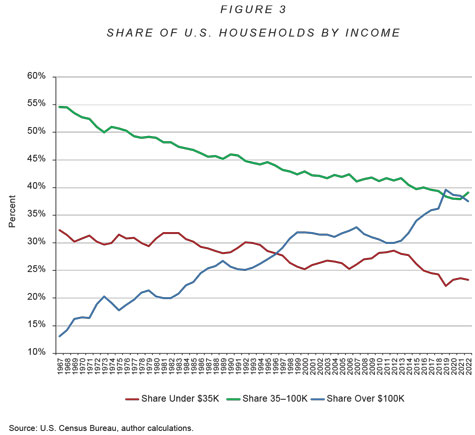See The Case for AI Optimism by Michael R. Strain. Excerpts:
"The Industrial Revolution did not eliminate the need for workers. But we do not need to go back to the 1800s to study this phenomenon: Contemporary examples will be more persuasive to many than events from two centuries ago.
The past five decades of American history have witnessed breathtaking advances in technology, including the widespread adoption of the personal computer, the internet, and the smartphone, as well as advances in robotics in the manufacturing sector. Yet despite these advances, we do not see an upward trend in the unemployment rate over this period. These numbers indicate that it has not become systematically more difficult for workers to find jobs.

"Between the end of the Second World War and 1980, manufacturing employment as a share of total employment fell from around one-third of all jobs to one in five. Today, that number is down to less than one in 10."

"Though economic nationalists argue that this trend was caused by globalization, in reality the primary driver (by a large margin) was technological change: Advances in technology, which led to substantial gains in manufacturing productivity, displaced many middle-skill, middle-wage manufacturing workers.
These labor-market disruptions were not confined to manufacturing: New technologies also eliminated the need for many middle-wage administrative, office, clerical, construction, and manufacturing-production jobs. Instead of an administrative assistant, many white-collar workers now have Microsoft Outlook and voicemail. Instead of depositing a check by handing it to a cashier, people use ATMs or their smartphones, or make and receive payments electronically.
But as disruptive as this wave of technological change was, the past several decades have been a net positive for American households. In fact, the story of the last half-century is mostly a story of upward mobility.
To illustrate, the chart below shows that over the past five decades, the share of households earning mid-level incomes — defined here as between $35,000 and $100,000, adjusted for inflation — has indeed declined. But on the whole, more households now earn six-figure incomes than they did 50 years ago."

"Meanwhile, although employment in middle-wage manufacturing and administrative jobs has fallen, a "new middle" is rising in its place. These growing middle-wage occupations include, among others, sales representatives, truck drivers, managers of personal-service workers, heating and air-conditioning mechanics, computer-support specialists, self-enrichment education teachers, event planners, health technicians, massage therapists, social workers, family counselors, paralegals, chefs, and food-service managers.
These jobs probably require a bit more education, more skills, and more experience than jobs in the old middle. They also involve more interpersonal interaction, meaning they call for workers with higher social intelligence, situational adaptability, and technical and administrative skills. But they do provide a pathway to the middle class."

No comments:
Post a Comment
Note: Only a member of this blog may post a comment.